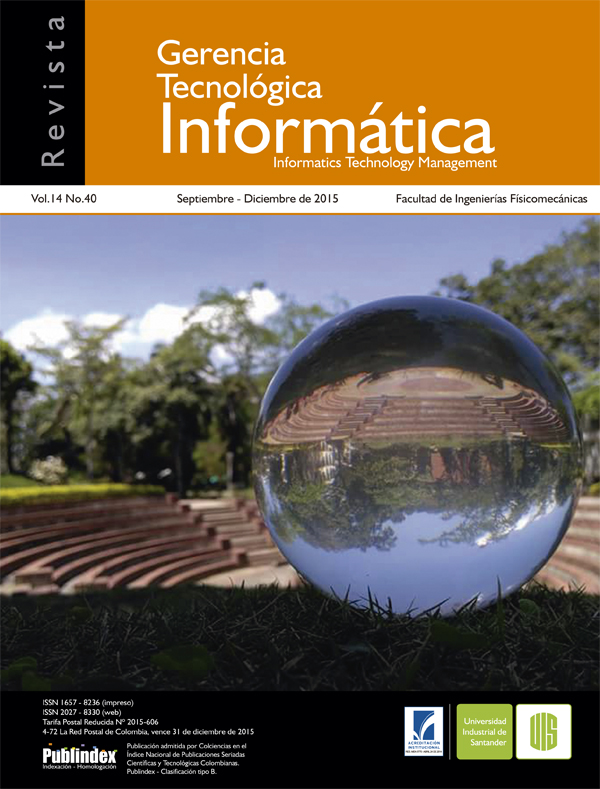Publicado 2016-11-03
Cómo citar
Resumen
El propósito de este trabajo de investigación es el desarrollo de un sistema con capacidad de procesar los datos obtenidos en tiempo real por parte de ciudadanos, los cuales ofrecen control de riesgo y de protección de privacidad y seguridad, para las comunidades urbanas. Para tal propósito, se diseñó una arquitectura capaz de gestionar las peticiones de los ciudadanos y generar las respuestas por parte del cuadrante más cercano a la solicitud. Además, el sistema tiene la capacidad de generar recomendaciones asociadas a los sitios que generen riesgo a las personas que lo visitan. Los resultados de las pruebas del sistema demostraron una mejora significativamente en los tiempos de respuesta de la Policía frente a las solicitudes de los ciudadanos. Este trabajo de investigación se desarrolló bajo los parámetros del Plan Nacional de Vigilancia Comunitaria por Cuadrantes (PNVCC) de la Policía Nacional de Colombia.
PALABRAS CLAVES: Computación urbana, computación ubicua, GPS, QR-Code, sistemas de recomendación, teoría de colas.
Descargas
Referencias
- ZHENG, Y., CAPRA, L., WOLFSON, O., & YANG, H. (2014). Urban computing: concepts, methodologies, and applications. ACM Transactions on Intelligent Systems and Technology (TIST), 5(3), 38.
- KUKKA, H., YLIPULLI, J., LUUSUA, A., & DEY, A. K. (2014, October). Urban computing in theory and practice: towards a transdisciplinary approach. InProceedings of the 8th Nordic Conference on Human-Computer Interaction: Fun, Fast, Foundational (pp. 658-667). ACM.
- SATYANARAYANAN, M. (2001). Pervasive computing: Vision and challenges.Personal Communications, IEEE, 8(4), 10-17.
- WEISER, M. (1991). The computer for the 21st century. Scientific american,265(3), 94-104.
- PAULOS, E., & GOODMAN, E. (2004, April). The familiar stranger: anxiety, comfort, and play in public places. In Proceedings of the SIGCHI conference on Human factors in computing systems (pp. 223-230). ACM.
- SHKLOVSKI, I., & CHANG, M. F. (2006). Guest Editors’ Introduction: Urban Computing--Navigating Space and Context. Computer, (9), 36-37.
- CHEN, X., ZHENG, Y., CHEN, Y., JIN, Q., SUN, W., CHANG, E., & MA, W. Y. (2014). Indoor air quality monitoring system for smart buildings. InProceedings of the 2014 ACM International Joint Conference on Pervasive and Ubiquitous Computing (pp. 471-475). ACM.
- UNIVERSITY OF CAMBRIDGE COMPUTER LABORATORY. (2004). A Transport Information Monitoring Environment (TIME): Event Architecture and Context Management (TIMEEACM), disponible en http://www.cl.cam.ac.uk/ users/jmb/TIME-EACM.htm
- DJAHEL, S., SALEHIE, M., TAL, I., & JAMSHIDI, P. (2013). Adaptive traffic management for secure and efficient emergency services in smart cities. InPervasive Computing and Communications Workshops (PERCOM Workshops), 2013 IEEE International Conference on (pp. 340-343). IEEE.
- YUAN, J., ZHENG, Y., ZHANG, L., XIE, X., & SUN, G. (2011). Where to find my next passenger. In Proceedings of the 13th international conference on Ubiquitous computing (pp. 109-118). ACM.
- Okazaki, S., & Matsushita, S. (1993). A study of simulation model for pedestrian movement with evacuation and queuing. In International Conference on Engineering for Crowd Safety (Vol. 271)
- CECCATO V., UITTENBOGAARD A,, BAMZAR R. (2013). Security in Stockholm›s underground stations: The importance of environmental attributes and context. Security Journal, vol. 26, no 1, p. 33-59.
- Yao, W., He, P., & Xu, S. (2015). P2P & LBS Technology-Based Mobile Police System Design. Journal of Computer and Communications, 3(09), 51.
- POLICÍA NACIONAL. (2009). ESTRATEGIA INSTITUCIONAL PARA LA SEGURIDAD CIUDADANA: PLAN NACIONAL DE VIGILANCIA COMUNITARIA POR CUADRANTES (PNVCC), Ediciones Policía Nacional, oficina de planeación, Colombia.
- LOPS, P., DE GEMMIS, M., & SEMERARO, G. (2011). Content-based recommender systems: State of the art and trends. In Recommender systems handbook (pp. 73-105). Springer US.
- ZHANG, B. W., YIN, X. C., CUI, X. P., QU, J., GENG, B., ZHOU, F. & HAO, H. W. (2014). Social Book Search Reranking with Generalized ContentBased Filtering. In Proceedings of the 23rd ACM International Conference on Conference on Information and Knowledge Management (pp. 361-370). ACM.
- SHI, Y., LARSON, M., & HANJALIC, A. (2014). Collaborative filtering beyond the user-item matrix: A survey of the state of the art and future challenges. ACM Computing Surveys (CSUR), 47(1), 3.
- YI, A. L. C., & KANG, D. K. (2014). Friends-andnative-people-aware approach for Collaborative Filtering. In Soft Computing and Intelligent Systems (SCIS), 2014 Joint 7th International Conference on and Advanced Intelligent Systems (ISIS), 15th International Symposium on (pp. 976- 979). IEEE.
